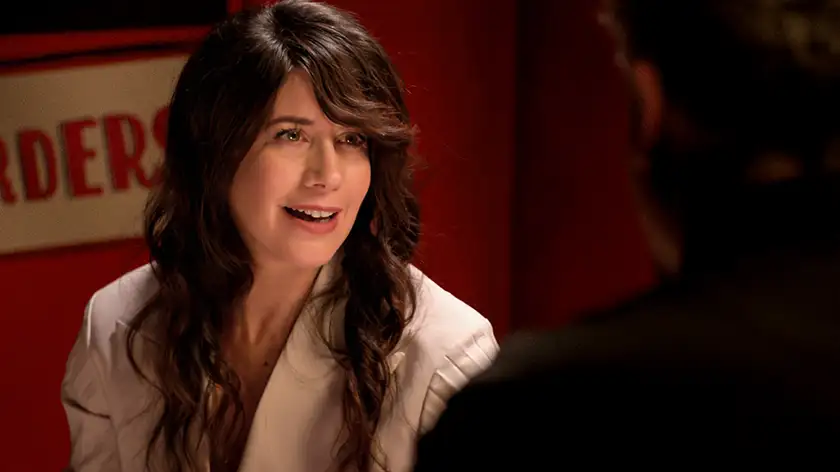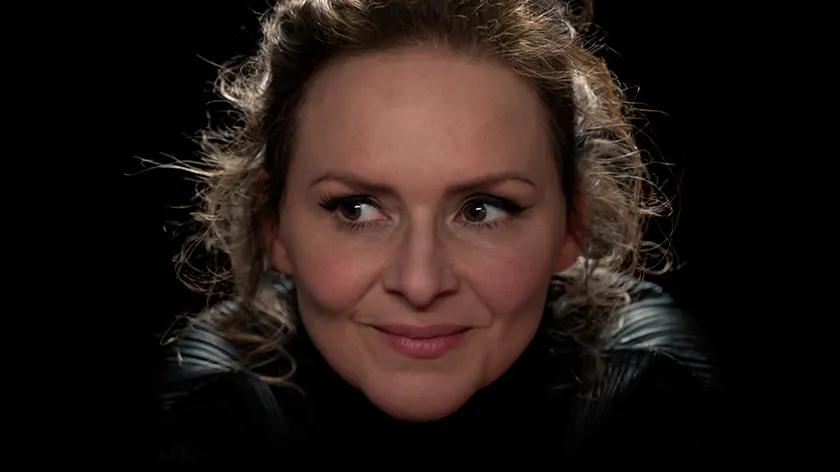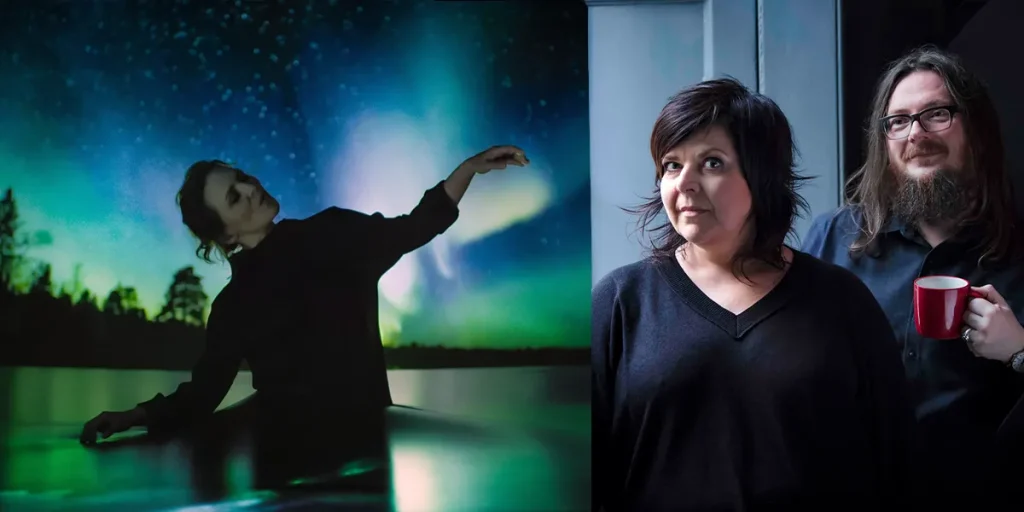We interview directors Iain Forsyth and Jane Pollard about The Extraordinary Miss Flower, filming music performances, and their collaboration behind the camera.
As the title suggests, The Extraordinary Miss Flower focuses on Geraldine Flower (Caroline Catz). After the latter’s funeral, her family discovers an interesting collection of her belongings, including secret letters from everywhere in the world, that may lead them to suspect that she was leading a life they had never known about. While her multiple lovers – and marriages – are certainly one of the key parts of this discovery, so is her potential double life as a spy. These letters served as an inspiration for the Icelandic singer Emiliana Torrini to compose an album about her titled “Miss Flower.”
Directed by Iain Forsyth and Jane Pollard, The Extraordinary Miss Flower comes out in UK cinemas on 9 May, 2025. Ahead of its UK release, we spoke with the two filmmakers about their approach to a movie that has so many different genres within it, the way they portrayed the musical performances on camera, and what makes their collaboration so successful after they first met more than 30 years ago when they were both students at Goldsmiths. Read the interview below!
Iain Forsyth and Jane Pollard on what inspired them to tell this story
How did you first get the idea for The Extraordinary Miss Flower?
Iain Forsyth: Our first contact with the story was Emiliana Torrini. We met Emiliana in Iceland after a mutual friend introduced us over dinner. When we met her, she had just recently come back from London, where she had been singing as a memorial for her friend’s mother, Geraldine Flower. She told us this story about the memorial and about how, afterwards, she went back to Geraldine’s flat with her friend; they discovered this box of letters and started to go through them. Her friend was beginning to learn new things about her mother that she might not have known before, and Emiliana felt inspired to write a song.
Jane Pollard: Emiliana is exactly as she comes across on film. She has a real mischievous glint in her eyes, and she is spellbinding to talk to. We could see how much of an impact this discovery had had on her and that she was already beginning to see the creative potential for where it might take her songwriting and potentially even become an album or film. A lot of the story elements are true, like the nine marriage proposals. There is also a hint of espionage, which is kind of true. The way she put this story together made us fall in love with it; we saw that she was a great storyteller and could definitely hold a film.
But it was only years after our meeting, when she finished writing the album, that the whole story came back to us, and we decided to make a film about it. The floor for the film was very open in terms of deciding what it was going to be, so we decided that we wanted to live in that spellbinding, crazy, and wild world of Emiliana’s imagination. We wanted The Extraordinary Miss Flower to be inside that world and match its spirit.
I.F.: It felt like that was the right way to creatively tell that story. For the album, Emiliana had not allowed herself to be anchored by reality because it was only a one-sided correspondence. We did not have any of the letters that Geraldine had written back to these men, so the whole thing had to exist in a world of imagination.
The directors on what makes The Extraordinary Miss Flower unique
This film is so many things at once in the best way possible. I know it is hard, but how would you describe it?
Jane Pollard: Yes, it’s so hard! We never really try and name what something is, because we work across art and film. That is the way we went into our first film, 20,000 Days on Earth (2014). We didn’t realise that it was a documentary until it went to Sundance and they told us it would play in the World Documentary section. That was honestly the first time we understood we had made a documentary. I think if you are pushing to find new languages and new ways of doing things, it’s useful not to give it a tag, to avoid pinning something down, and removing some of the things that used to guide us. We love those old music shows on the BBC, and that all happened inside a studio, often with very bold and quite abstract sets.
There is another reference that we showed Emiliana: the series The Strange World of Gurney Slade by Anthony Newley. It aired in 1960, and it has had a real impact on us. It had a huge influence on David Bowie; that is how we found out about it. I think it gave us a language and a way of describing how we wanted to operate to the cast and crew in how direct we wanted the performance to be, and how realistic we would build the sets It’s rare to see music performed on film in this way, where it is coming down the camera and aimed at the audience.
Iain Forsyth: Unless it’s a musical, which is what I guess I have been reluctantly calling The Extraordinary Miss Flower. It is such a loaded term that you don’t want to use, but I think on some level it’s certainly a cousin of a musical, let’s say.
J.P.: It’s the black sheep of the musical.
Iain Forsyth and Jane Pollard on the challenges they faced and their collaboration
With so many elements at play, what was the biggest challenge in making The Extraordinary Miss Flower?
Iain Forsyth: I think for most people, the challenge with making any film is the limited time and the limited budget. In particular, for The Extraordinary Miss Flower, we really wanted to try and frame these challenges in a positive way. Rather than being tied down by what we could not afford or did not have time for, we turned that into something we could use to our advantage. For example, the speed of having a budget that is not excessive was helpful because it allowed us to move quickly. Having limited time gave us a focus and energy on those two days when we were working with the band and the cast to be able to make the best of it.
We tried to make it a fun and enjoyable process as opposed to your usual kind of indie filmmaking, which is often back-breaking and exhausting work to try and get everything done. I hope that comes across on screen.

Jane Pollard: A lot of goodwill and love went into the film as well, and I think you can see it on the screen. I think we also somehow managed to harness the energy of the crew, which is something they did. You can feel the energy and what it was like to be in that room during filming when you watch The Extraordinary Miss Flower. It is also like all those moments are truly happening for you, live, and it is a real challenge to do that, and a huge achievement. It is one of the things I enjoy the most about the film, we had a great crew.
You have been working together for quite some time now. How did you start collaborating and what makes this partnership work?
I.F.: We met at art school 30 years ago in London. We both moved from different ends of the country to London to go to art school, and we very quickly and organically began working together. We did not have any sort of grand vision that this would be a lifetime’s endeavour at that point. We just both felt that what we were able to do together was more satisfying and successful.
J.P.: And rewarding too. Maybe it felt more ambitious, like it was bigger than us, than the sum of two people. I think we also had that student attitude of reacting to your circumstances and trying to figure out who you want to be and what you believe in. It is the ethical, moral, and personal foundation of your practice and your life. At Goldsmiths, our art school at the time, there was a lot of very big and empty art, a lot of big ideas without much substance to them. We whined about that a lot and bonded through complaining about everybody else and how it could be betterI.F.: Those years are so formative. I think your early twenties are such a pivotal age in terms of who you become and the person you aspire to be. We went through that together and made those decisions together, which forges an alliance that is somehow very difficult to break even if you wanted to.
The musical aspect of The Extraordinary Miss Flower
The music and performances are such a big part of the film. How did you work on including them in the story and having such a specific visual style for them?
Jane Pollard: We used the songs as the foundation for the script, so the first thing we did was order them. We put them in the order that we thought made the most amount of sense for a journey for us. And then we set about adapting each song for the camera and including the letters at the start of each song. We worked with Simon Byrt, who is Emiliana’s co-writer, and we were very lucky to have him on The Extraordinary Miss Flower as musical director. He adapted all of the songs and worked on the new versions for the film, but Simon also scored the whole movie, so it feels like it comes out of one musical language and world.
The songs were the foundation for the script, and then it was about kind of coming up with ideas for how to join them and ways of disrupting the flow and creating an intermission. We wanted to have this moment with one instrumental track that would bring alive this kind of butterfly dance.
Ian Forsyth: A lot of it goes back to this idea of music television from the ’60s that inspired us to only use a few brushstrokes to show the entire picture. It was a very minimalist and impressionistic take on set design.
J.P.: We used the black box of a studio like the inside of Emiliana’s head. Everything you see is her hallucination in some form, they are sketchy and kind of abstract as they might be if they existed only in your mind. We also love doing our effects on camera and knew we would not have a budget that would allow us to do them in post.
We had a brilliant DP, Erik Wilson: he likes playing as much as we do. We spent a lot of time with the space between the camera lenses and the subjects: we used glass, mirror, crystal, and light to distort and bend the image and create the atmosphere of what we are filming. We also wanted to use the space behind the camera, so we used a lot of big back projections to bring this weird dreamscape to life.
We hear many different songs in The Extraordinary Miss Flower. Do you each have a favourite one, or a favourite moment overall?
J.P.: That changes. I think for me it is probably “The Golden Thread.” It’s such a simple and great song, and I think the visualisation of it worked so well. We used a mirrored dressing table: on one side, we showed Caroline Catz and on the other, Emiliana. I think it’s very moving and a real manifestation of what the song was saying, especially the way that Eric choreographed the long shots when the faces cross into one another. It was what we hoped The Extraordinary Miss Flower would do. That is the moment when I cried on set. It was amazing, I still get goosebumps when I watch it now.
I.F.: I have a soft spot for “Dreamers.” We only have the first half of the song in the film, and the second half is over the closing credits, but it is such a beautiful piece of songwriting and a beautiful piece of music. I absolutely adore it.
J.P.: I think that is the earworm, it is the song you keep singing afterwards and can’t get rid of it for ages. It’s great.
I.F.: It’s the one you can hear the crew humming on set. You can see them packing up at the end of the day, everyone getting ready to go home, and that song seemed to stay with everyone.
Iain Forsyth and Jane Pollard on the audience’s reaction to The Extraordinary Miss Flower
The film is coming out today in cinemas. What do you hope that viewers get from it, if anything?
Jane Pollard: I just hope they come and see it in the cinema, because it’s such a visual feast. From an audio point of view as well, it’s built on these incredible songs. Hearing it and seeing it on a big screen with a great sound system will make such a difference. I hope it can be a catalytic converter for someone else, like a spark that opens up somebody else’s mind and makes them think. Maybe that is what all of our work is trying to do, the way that other people have been great influences in our lives.
I know the film premiered at the London Film Festival back in October. How was that experience for you as filmmakers to attend the festival with The Extraordinary Miss Flower?
Iain Forsyth: It was fantastic. LFF was the first time we saw the film with an audience in the same room. I think cinema is such a communicable experience, even though you are sitting in the dark and all facing the same way, you do go through something together, it is a shared experience in that room. There is nothing more satisfying than feeling and hearing that energy when everyone is laughing at the same joke. When you are sitting in a little dark room on your own, putting the film together, you hope that it’ll resonate with the audience, and it is beautiful to watch and hear that actually happen.

The directors on their future projects together
Do you have any future projects, or something that you hope to work on together after The Extraordinary Miss Flower?
Iain Forsyth: The next film we’re working on at the moment has not been announced yet, so we really can’t talk about it.
Jane Pollard: We’re not sure when it will be announced, but it’s very exciting! And then just trying to make art wherever we can. We’re currently doing a piece called Londonion as part of the Neo-Ancients festival in Stroud that is opening this weekend. It’s again about those moments of music and film coming together that we are looking at.
I.F.: It is amazing, and it’s nice to be outside. We are here in a forest. We’ve just spent the last few months editing for the new film, so we’ve been staring at a screen in a dark room for weeks and weeks. I am happy to be here.
This interview was edited for length and clarity.
The Extraordinary Miss Flower will be released in UK & Irish cinemas from 9 May, 2025. Read our review of the film!
Header Credits: Emiliana Torrini in The Extraordinary Miss Flower (BFI) / Directors Jane Pollard and Iain Forsyth (Paul Heartfield)

